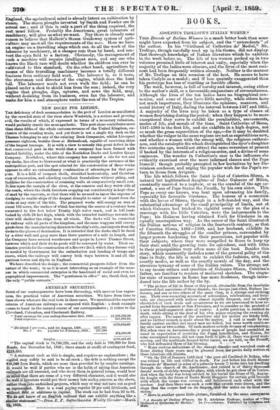AMERICAN SECURITIES.
SOME of our contemporaries have been discussing, with more or less vague- ness, the practical value of American securities. We have from time to time shown what are the real tests in these cases. We mentioned the superior returns of American railways as compared with English : a fresh example comes to hand in the natural course of our correspondence; it refers to the
Cleveland, Columbus, and Cincinnati Railway.
"Total earnings for year ending December 31st, 1858 $1,106,103.90 Total expenses 531,040.95 "Dividend 5 per cent., paid 1st August, 1858 $237,30) Do. 5 do. payable 1st February, 1859 237,305 Surplus S100,444.03
"The capital stock is 84,746,220, and the only debt is $38,000 for Iron Hondo, due December 1st, 1859; there stands at erecht of contingent fund, $218,683.
"A statement such as this is simple, and requires no explanations ; the capital may safely be said to be all stock ; the debt is nothing except the $38,000 Iron Bonds, whioh are more than provided for by surplus earnings. It would be well if parties who are in the habitof saying that American railroads are all unsound, and who decry them in general terms, would bear in mind that there are some of a very different character, and it would also be well if investors would put their money into such a concern as the above, rather than into unfinished projects, which may or may not turn out as good as represented. Here is a road paying regular 10 per cent -dividends, and without debt or additions to Capital. The stook can be had from 92 to 94. We do not know of an English railroad that can exhibit anything like a similar statement."—From E. F. Satterthwailes Treekly Circular—March 23, 1859.
S575,054.03 474,610.00


























 Previous page
Previous page